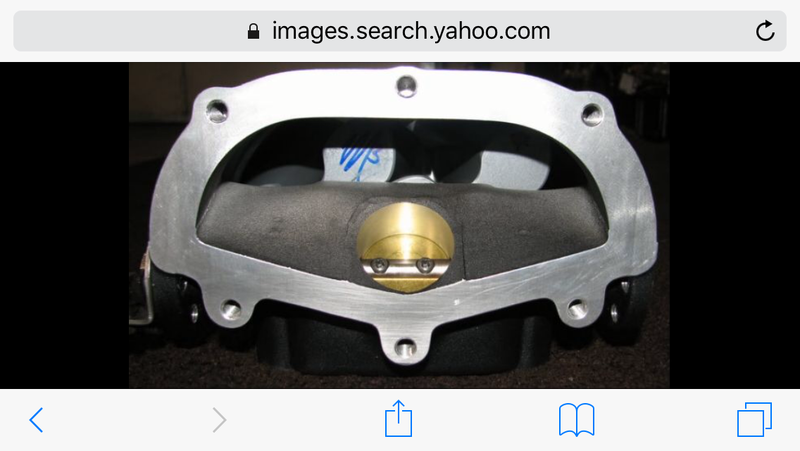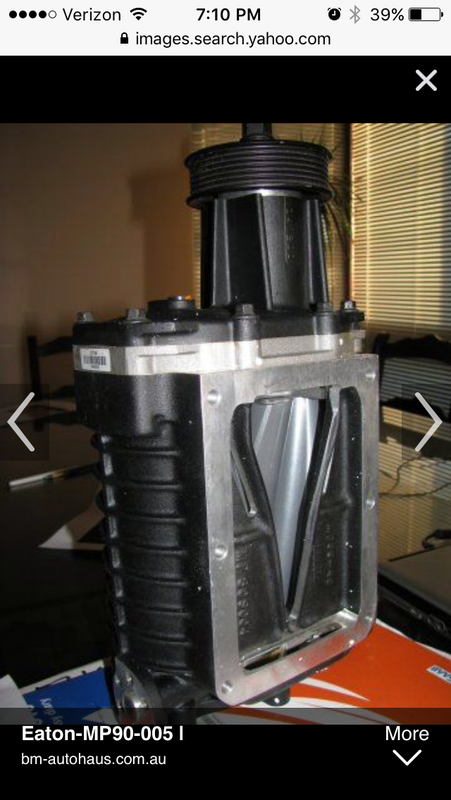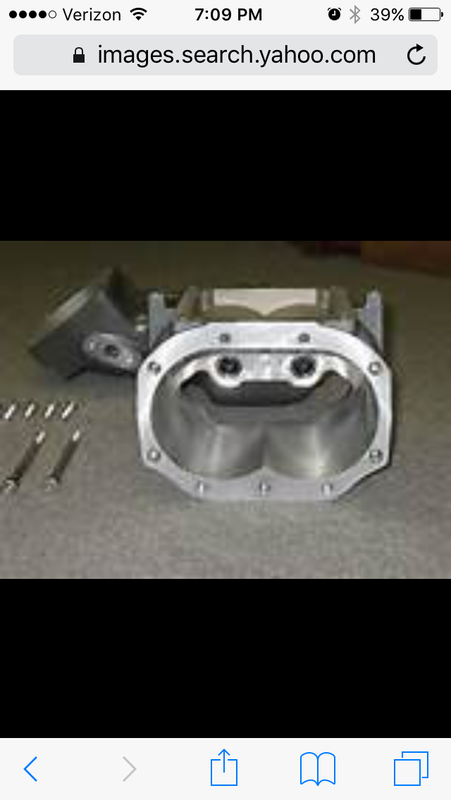(I need to get some other pictures off of another HD so I will fill those in when I get a chance and replace those pics when I have better ones)
Ok basically what it boils down to is that you have a device that is meant to move air. When, where, how and how efficiently all play into what you are looking to do. If were to look at the M90's over the years you would see a lot of differences in port configuration and inlet and outlet shape.
Over the years there were the early M90's that were used on 89-93 Ford Supercoupes. These had a very low inlet port that was rounded and sat very far below the rotors so that the rotors were in a turbulent wash of air entering into the rear of the supercharger and just wasn't an efficient way of air into the supercharger by later standards. We started porting these superchargers by milling the inlet closer to the bearings and then blending the the edges so that the air could enter and move to the sides of the case where it was more easily picked up by the rotors. Several people and manufacturers made dividers that helped divert air into the sides with mixed success. We used thermocouples and MAF airflow to measure differences in how a stock blower would compare to a ported blower. One of the first things found was that the throttle body was way too small and even though that you would increase the blowers ability to move air the restriction would cause the outlet temp to rise quite a bit (nearly 100*).
In working with all size roots blowers in the past I have noticed that if the air filter is clogged, which they do very often in concrete plants that they would have outlet temps climb very high. An example was a system using a 35HP motor to drive blower at 2-3 psi was overheating and shutting down and the air outlet temps of the blower were well over 200*. I looked at the system and found that the air filter was so clogged that it had collapsed and was not even able to produce enough air to fill the concrete into the bag. After replacing the airfilter the output temp had fallen into the 130's where it would normally run and the motor was not tripping out the breaker and its temperature was in check as well. This used to happen all the time and I would have to troubleshoot the blower system just in order to get the packer to work.
On the M90 I thought this may be an issue as well and the stock TB is only 60mm, modifying the inlet plenum and using a modified BBK 75mm TB made a pretty big difference in outlet temps on the early M90's as well and when using the ported early supercharger helped a lot. Outlet temps dropped, boost increased and flow through the meter increased as well. It's worth mentioning that the drive ratio on these blowers is 2.77:1 which is a lot higher than the GM is. The 89-93 uses a 3.135" supercharger pulley and uses a jackshaft as a double overdrive.
(Insert picture of unported and Ported Gen 1 supercharger)
Later for the 94-95 Thunderbird SC they received the Gen 3 Eaton M90. This is the same configuration of the GM M90, but without the inlet and outlet flange cast in and the first with the internal bypass valve. Ford used the Eaton as it came off the shelf whereas GM elected to have a separate casting made for their application. This blower is different as the "floor" was moved closer to the center line the floor now is closer to the rotors so that the air is forced to follow in and move to the outsides. The inlet was also extended into the back of the bearing plate to give just a little more timing for air to enter the area between the lobes. the "roof" was redesigned so that it no longer had a ridge between the rotors the outlet no longer had "cleavage" and the rotors were coated with an epoxy film to keep air from slipping back to the inlet do to the decreased tolerance. The GM Gen 3 is the same thing but as stated got a cast in inlet and flange with integral bypass valve. On the Ford this actually increased the torque and HP and Torque from 210/315 to 230/330.... the funny thing is that the drive ratio decreased, they actually put a larger pulley on the supercharger (3.275") but the boost pressure remained the same and horsepower went up. So now we are sneaking up on a higher efficiency supercharger with no other changes that the supercharger and about .2 compression ratio increase. The cams are even smaller in later years.
(picture of inside of Gen 3 Ford M90 and GM M90)
Now we get into the Gen 4 superchargers which are the MP series of roots superchargers.
This time the inlet and outlet have changed significantly the inlet port is closer to the bearings and the intake port timing has been increased by quite a bit. As the rotors rotate they uncover the inlet to allow air into the area between the lobes and case where air is trapped and is moved around to the outlet. The more time there is for air to enter this area, to a limit, the denser the charge that it can move. The outlet is been changed also. You will notice that the port is now longer and thinner and extends to the end of the flange. You don’t really want to widen the V in the outlet as that basically would serve the same purpose of the noise canceling ports but much less effective. The V outlet’s shape matches that of the rotors as they come together to squeeze the air out. By changing the angle it hurts lower end efficiency.
Porting Eaton Superchargers
There are a lot of different Eaton superchargers each with their own individual needs and ability of porting material to work with some can be ported more than others. One example would be a Jaguar M112 vs a Lightning M112.
Porting on the M90 is going to depend on what you want to do. Basic porting will remove all the rough edges and smoothing the inlet from the throttle body all the way to the rotor area.
The first thing you want to do is to cover all the machined surfaces in Blue tape a few layers thick so you don’t damage the surface.
Using flapper wheels that are 1” in diameter and 1” long work great, cut fast, don’t get away from you like a burr can and leave an almost finished surface. I start with 60-80 grit and will finish with a 220 grit. Just about the time you get ready of the 220 switch to it and use it just long enough to remove the edges as they will cut into the material much faster when they are new. If you haven’t already figured out you will need an extension to be able to reach to the rotor area. They do make extension adapters to get to the harder to reach areas for ¼” shaft that are 6” long. They come with a Phillips or flat head so I usually replace them with set screws anyway.
For getting to the lead in area you really should use cartridge rolls for this as they are smaller and easier to get into that area. You can use standard cartridge rolls, I like to turn them around backwards so that the fat portion is at the front and you have the diegrinder is at the TB inlet. This is the point where you want to tape up the inside of the inlet where you just spent a lot of time making smooth, nothing like a careless steel bar mess up some of the work you just did. You can use the same extension and operate the cartridge roll. Start out with a 220 or so as you will get close to the edges of materials thickness.
For the outlet removing the bolt bosses and shortening them is of some help, but you will have more to gain on the inlet side of the supercharger. This is what I consider a mild port and will pick up a little more flow and efficiency. The drive ratios are very low compared to what I am used to on Fords where we drove them at more than 3:1 where to get to the stock drive ratio (2.77:1) on a GM would take a 2.5” pulley.
Then the porting starts getting more extreme, this is where you start changing where the efficiency and flow really start to come in. With stock port timing the blower is operates just as the chart from Eaton suggests, but as you change port timing then it starts to shift this is also where speeding up the blower needs to take place. You are starting to get to the point where there is less distance between the inlet and outlet, so as the air comes out in pulses if the speed isn’t increased then there is more time for pressure on the outlet to leak back to the inlet. This can be partially slowed by welding the silencer ports and by speeding up the blowers speed. Part of picking up speed for the blower is to produce more boost and part is to keep it at peak efficiency. Here is a couple of pictures of an Magnum Powers MPX blower this is one of the highest output M90 based superchargers around. These have proven to provide 60hp increases but at insane speeds. Speeds in excess of 20K are used. We have run the factory M90 bearings in the 18K range on ported superchargers without too many issues. If you look at the port and how it is shaped you can see what I am talking about when I mean timing. This is not an actual M90, but is an aftermarket case for the M90. It also has a matched inlet that needs to be used with it.














